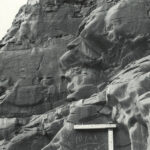| Artefact ID | 1416 |
| TM ID | TM 105795 |
| Findspot (DEChriM ID) | 43 (Biʾr al-ʿAyn) | Class | Textual |
| Material | Stone |
| Writing medium | Graffito |
| Text content | Subliterary |
| Language | Greek |
| Description | I.Pan du désert 14; IGChrEg 351; SEG XXXII 1590: Greek graffiti On the same rock as other several Coptic (A) graffiti, some Greek graffiti possibly from the early Byzantine period if the Greek and Coptic texts are to be considered as the results of the same period of frequentation by Christian communities [but images are lacking to confirm the hypothesis]. They are presented as a whole in Bouriant's editio without distinction between Greek and Coptic texts (all transcribed in Coptic letters); Lefebvre 1907 and Bernand 1977 gave a new edition of what they considered Greek texts:
On the same rock as I.Pan du désert 13; IGChrEg 352. |
| Selection criteria | Mention of Christian individuals/communities, Christian terms/formulas/concepts, Christian onomastics, Christian symbols/gestures/isopsephy, Archaeological context associated with Christian markers |
| Date from | 300 |
| Date to | 499 |
| Dating criteria | Archaeological context (association with Coptic A graffiti) and onomastics. |
| Absolute/relative date | Relative date |
| Archaeological context | Isolated rock of approx. H. 4 m x L. 5 x W. 3 m covered with graffiti, including a set of Ptolemaic graffiti related to hunting activities and a set of Christian graffiti (Greek and Coptic). |
| Accession number | Wādī Biʾr al-ʿAyn, in situ. |


 Json data
Json data




